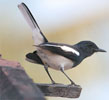The crow
 The crow is a teasing bird. It is very regular bird of our country. It is very chopper. It looks ugly. Its scream is “ka-ka”. Yet it is a useful beast. It feeds on dead beasts and filthy things. The kite is also of the same pattern and character. Exceptionally it exists in plants brunches. It can set up a lot of coconut trees. It builds its nest with tees leaf, limb or with powder things. It goes out from nest in morning for gather food and arrives at evening. It don’t become family.
The crow is a teasing bird. It is very regular bird of our country. It is very chopper. It looks ugly. Its scream is “ka-ka”. Yet it is a useful beast. It feeds on dead beasts and filthy things. The kite is also of the same pattern and character. Exceptionally it exists in plants brunches. It can set up a lot of coconut trees. It builds its nest with tees leaf, limb or with powder things. It goes out from nest in morning for gather food and arrives at evening. It don’t become family. 



